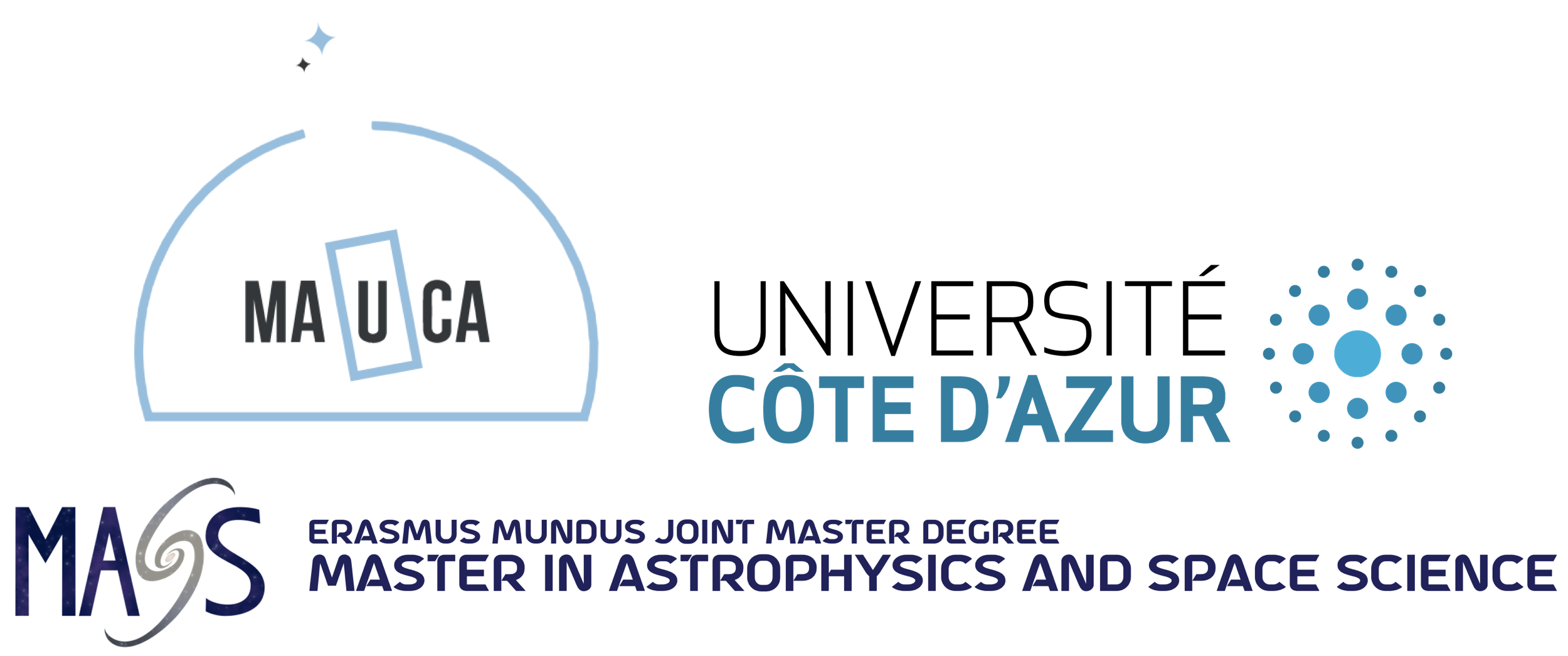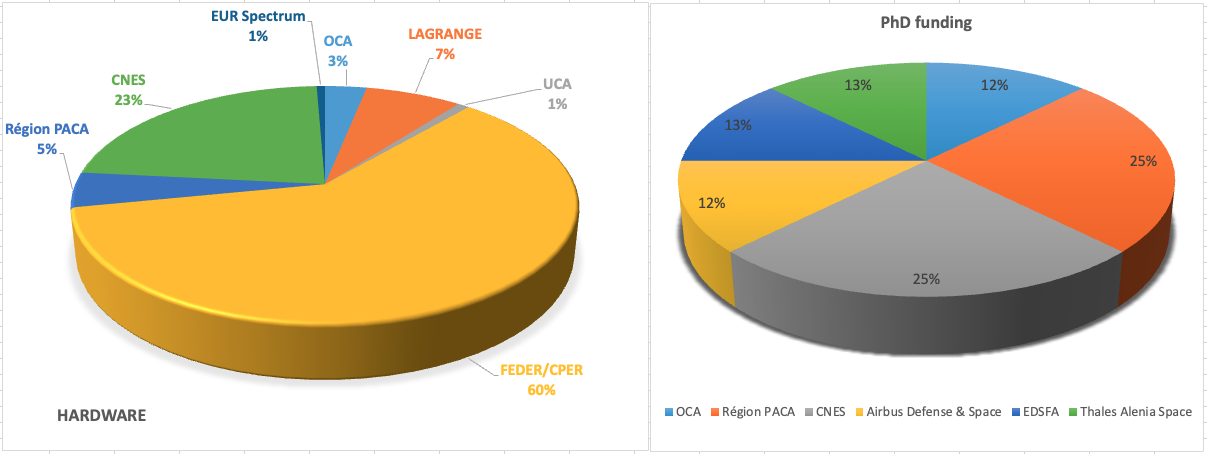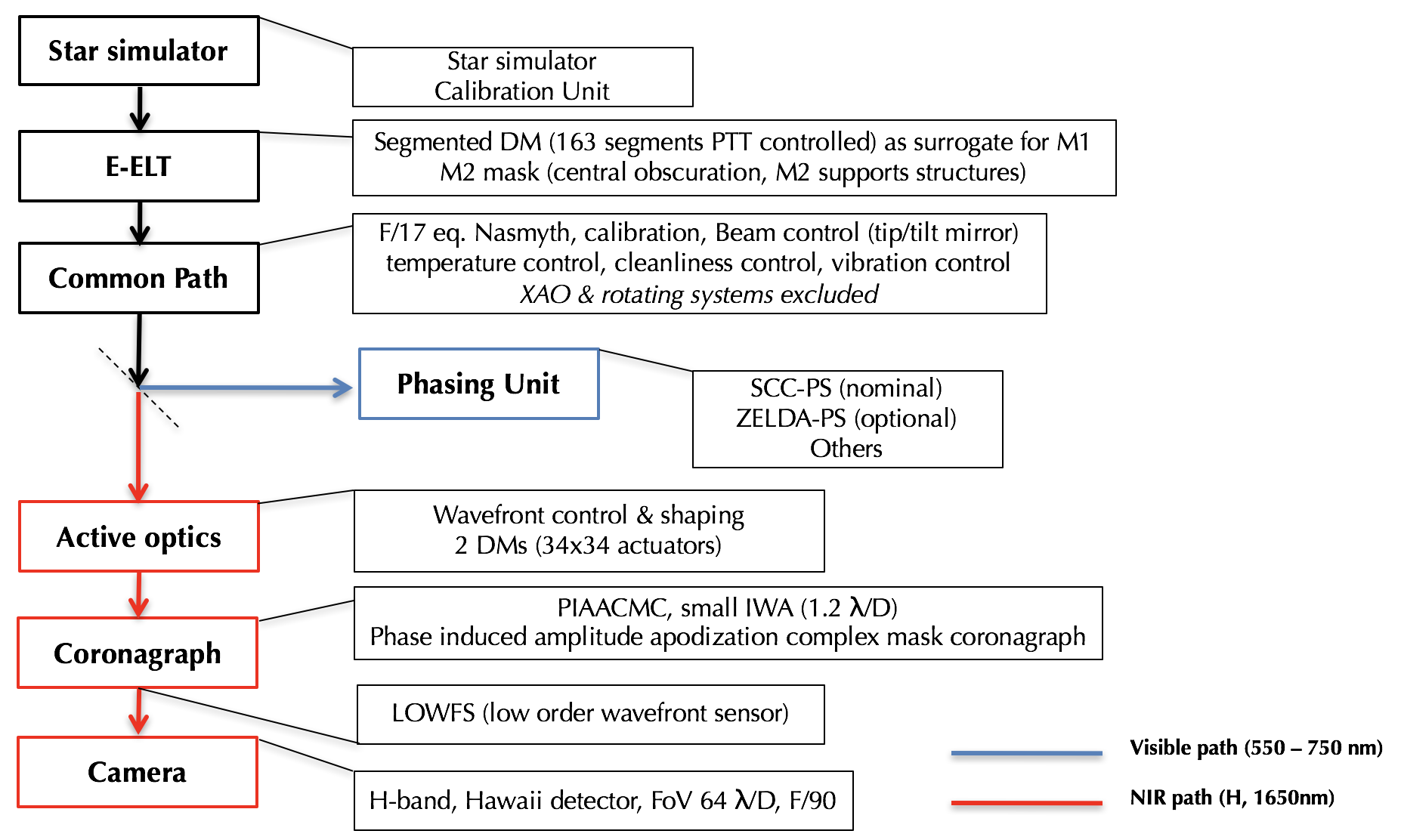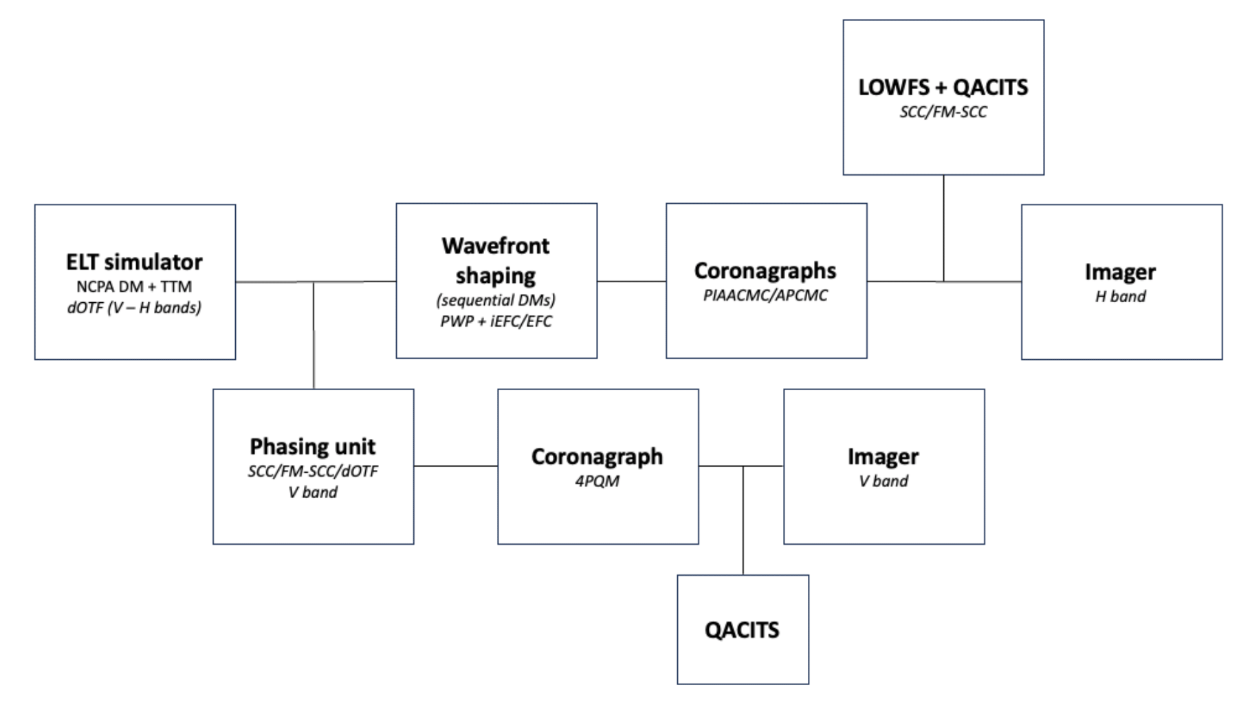Projects in progress
- Details
The SPEED facility is used in an educational context during teaching lectures given in Licence (L3 - UCA) and Master (M1/M2 Astrophysics MAUCA and MASS) degrees.
In the Physics license degree
SPEED is part of three elective and supervised projects given in the second semester of the 3rd year on coronagraphy, cophasing optics and the JWST.
[1] Coronagraphy: diffractive optics for exoplanets detection
[2] Cophasing optics: active optics for astronomical observations
[3] WebbPSF[edu]: understand JWST's images and development of the WebbPSF[edu] tool
In the Astrophysics master's degree
SPEED is part of instrumental courses given in various METEORs (Modules Experiments ThEOry Research) of the MAUCA master's degree (http://mauca.unice.fr/) and in two instrumental lectures in the MASS master's degree (https://www.master-mass.eu/).
[4] CSO: Cophasing Segmented Optics (elective lecture - M1/M2 MAUCA)
[5] SEFA: Software Engineering for Astronomy (elective lecture - M1/M2 MAUCA, M2 MASS)
[6] IE: Imaging Exoplanets (elective lecture - M1/M2 MAUCA)
[7] Telescope Optics - Erasmus Master MASS (Master in Astrophysics and Space Science, compulsory course)
[8] Cophasing Optics - Erasmus Master MASS (Master in Astrophysics and Space Science, compulsory course)
Summary of courses currently proposed:
| Lecture | University year in which the lecture was provided |
| Supervised project on coronagraphy [1] | 2018-2019 / 2019-2020 / 2020-2021 / 2024-2025 |
| Supervised project on cophasing [2] | |
| Supervised project on WebbPSF[edu] [3] | 2022-2023 / 2024-2025 |
| Cophasing Segmented Optics [4] | 2018-2019 / 2019-2020 / 2021-2022 / 2023-2024 |
| Software Engineering for Astronomy [5] | 2023-2024 / 2024-2025 / 2025-2026 |
| Imaging Exoplanets [6] | 2024-2025 / 2025-2026 |
| Telescope Optics [7] | 2022-2023 / 2023-2024 / 2024-2025 / 2025-2026 |
| Cophasing Optics [8] | 2022-2023 / 2023-2024 / 2024-2025 / 2025-2026 |

- Details
As of December 11th 2023, the SPEED project is a 796 k€ project (hardware). Funding came from various sources as described below. The project also received funding support from CNES, Airbus Defense & Space, Thales Alenia Space, Région PACA, OCA, and EDSFA for PhD contracts, and from the Lagrange laboratory for IUT and Master's degrees internships.
In particular, speed has received funding from 3 CNES R&T program:
- R&T CNES 2015-2017 [reference 4500049994/DIA094]
- R&T CNES 2019-2021 [reference 4500063765/DIA094]
- R&T CNES 2023-2025 [reference R-S23/SU-0002-088-03]


- Details
Study |
Collaboration |
| Fresnel/Talbot effect, instrumental contrast design | LESIA, France |
| Self-coherent camera phasing sensor (SCC-PS, cophasing) | LESIA, France |
| ZELDA-PS (cophasing) | LAM, France |
| PIAACMC design study | NAOJ, USA |
| iEFC (implicit Electric Field Conjugation) | Univ. Arizona, USA |
- Details
Current team
Name |
Role |
| P. Martinez | Scientific manager (PI) |
| C. Gouvret | Optical study and AIT manager |
| J. Dejonghe | Opto-mechanical study |
| M. Beaulieu | System study and end-to-end modelling |
| A. Marcotto | AIT |
| A. Spang | Opto-mechanical engineering and AIV |
| C. Sallard | PhD student 2024-2027 (Thales Alenia Space /Région PACA) |
| I. Lapassat | Administrative manager |
Former associates
Name |
Role |
| R. Dharmadhikari | PhD senior fellow at the Indian Institut of Astrophysics (September - December 2023) |
| G. Doyen | PhD student 2019-2022 (CNES/UCA), PhD withdrew in June 2022 |
| O. Preis | Project manager |
| L. Abe | High-contrast simulation and validation expertise |
| K. Barjot | Internship M2 |
| M. Postnikova | Internship M2 |
| PhD student 2017-2020 (CNES/OCA), PhD withdrew in September 2018 | |
| P. Janin-Potiron | Internship M2 |
| PhD student 2014-2017 (Airbus Defense & Space/Région PACA), awarded PhD SF2A 2018 | |
| Y. Fantei | Software consultant |
| J-B. Daban | Project manager |
| L. David | Internship IUT |
| P. Belzanne | Internship IUT |
| A. Chambinaud | Internship IUT |
| H. Philippon | Internship IUT |
- Details
Publication list with hyperlink
As of 2025 July 7th, the project gathers:
21 conference publications and 13 refereed publications, and 2 defended PhD theses.
Project overview publications
[1] SPEED: get ready for (PCS) rush hour
Martinez et al. ESO Messenger 2023 n°190
[2] The segmented pupil experiment for exoplanet detection VI. From early design to the first lights
Martinez et al. Proceeding of the SPIE 2022
[3] The segmented pupil experiment for exoplanet detection V. System control and software infrastructure
Martinez et al. Proceeding of the SPIE 2022
Martinez et al. Proceeding of the SPIE 2020
Martinez et al. Proceeding of the SPIE 2018
[6] The segmented pupil experiment for exoplanet detection. II. Design advances and progress overview
Martinez et al. Proceeding of the SPIE 2016
[7] The segmented pupil experiment for exoplanet detection
Martinez et al. Proceeding of the SPIE 2014
Martinez et al. ESO Messenger 2015 n°159
Key hardware studies publications
Martinez et al. A&A 2025, under press
Martinez et al. MNRAS 2024, Vol. 532, 2
[3] Revisiting optical transfer function-based focal plane wavefront sensors for correcting NCPAs
Martinez et al. Proceeding of the SPIE 2024
[4] Differential optical transfer function (dOTF) wavefront sensing with the SPEED test-bed
Dharmadhikari et al. Proceeding of the SPIE 2024
Sallard et al. Proceeding of the SPIE 2024
Martinez et al. A&A 684 L5 Letter 2023
Martinez et al. A&A 2023, Vol. 680, A6
[8] Gearing up the SPEED wavefront shaping strategy
Doyen et al. Proceeding of the SPIE 2020
[9] Metrological characterization of the SPEED test-bed PIAACMC components
Barjot et al. Proceeding of the SPIE 2020
Beaulieu et al. MNRAS 2020, 498
Martinez et al. A&A 2020, Vol. 635, A126
[12] Fast-modulation imaging with the self-coherent camera
Martinez, A&A Letter 2019, 629, L10
[13] An end-to-end Fresnel propagation model for SPEED: PIAACMC implementation and performance
Beaulieu et al. Proceeding of the SPIE 2018
[14] Design, specification and manufacturing of a PIAACMC for the SPEED testbed
Martinez et al. Proceeding of the SPIE 2018
Janin-Potiron et al. A&A 2017
Beaulieu et al. MNRAS 2017, 469
[17] Self-coherent camera as a focal plane phasing sensor
Janin-Potiron et al. A&A 2016, 592, A110
[18] The self-coherent camera as phasing sensor: from numerical simulations to early experiments
Janin-Potiron et al. Proceeding of the SPIE 2016
[19] SPEED design optimization via Fresnel propagation analysis
Beaulieu et al. Proceeding of the SPIE 2016
[20] The self-coherent camera as a focal plane phasing sensor
Janin-Potiron et al. EAS publications series 78-79 2016
Preis et al. Proceeding of the AO4ELT 4th Edition 2015
[22] A Fresnel propagation analysis for SPEED
Beaulieu et al. Proceeding of the AO4ELT 4th Edition 2015
Janin-Potiron et al. Proceeding of the AO4ELT 4th Edition 2015
Project related publications
Martinez, A&A 684 L5 Letter 2024
[2] Analytical decomposition of Zernike and hexagonal modes over a hexagonal segmented optical aperture
Janin-Potiron, Martinez and Carbillet, OSA Continuum 2018 - 1(2), 715-726
[3] Laser guide stars used for cophasing broad capture ranges
Martinez and Janin-Potiron, A&A Letter 2016, 593, L1
PhD Thesis
Janin-Potiron Pierre, Université Côte d’Azur 2017 (Prix SF2A 2018)
[2] Imagerie optique à très haut contraste : une approche instrumentale optimale
Beaulieu Mathilde, Université Côte d’Azur 2017
- Details

Figure 1 - Architectural principle of the SPEED bench.
The architectural principle of the SPEED bench (Fig. 1) is presented in the above diagram. The field of view of interest is restricted to 8 λ/D in radius given the aimed objective of high contrast at small angular separations. The bench is therefore composed of a visible cophasing optical path (in blue) and a near-infrared path (in red) dedicated to high contrast.
The common path is in orange colour in the 3D CAO view of the bench presented above (Fig. 2). The visible path dedicated to the optical cophasing corresponds to the blue lines and the near-infrared path, dedicated to high-contrast imaging, corresponds to the red lines.

Figure 2 - 3D CAO view of the SPEED bench.
The Speed bench is installed in a clean-room environment (ISO7 classroom, Fig. 3) at the Lagrange Laboratory, FIZEAU building on the Valrose campus in the city centre of Nice.

Figure 3 - Pictures of the SPEED bench, ISO7 classroom.

Figure 4 - Concept diagram of the SPEED FPWFS.
Concept diagram of the SPEED test bed showing the main building blocks and highlighting the focal plane wavefront sensors available (Fig. 4) and involved in the calibration and observing modes.
Figure 4 presents a concept diagram of the SPEED test bed presenting the main building blocks, highlighting the FPWFS present in the bench for flattening and shaping the wavefront. SPEED offers the SCC in both optical (cophasing) and NIR infrared arms for complex field estimation for shaping the wavefront, with FM-SCC extension in both arms. The dOTF is also used in both optical paths for NCPA estimation and correction using the ASM. The PWP is being implemented in the NIR path and coupled to EFC, while iEFC is available for generating a dark hole in the science image. In addition to these wavefront sensors, a QACITS sensor is available. QACITS (Quadrant Analysis of Coronagraphic Images for Tip-tilt Sensing) is a tip-tilt sensing technique based on the analysis of the flux asymmetry of the coronagraphic image (FQPM, PIAACMC/APCMC) that appears when the star image is not perfectly centred on the coronagraphic focal plane mask.

Figure 5 - Schematic representation of the SPEED control software architecture
Figure 5 describes workstations distribution, GUIs(in red), controllable devices (green areas) and devices dispatch, as well as sub-GUIs or actions: in red (using dedicatedGUIs), in blue for manual operation, in brown using a separated bench, and in green for monitoring.
The SPEED test-bed being more complex than a simple laboratory test bench but less demanding than an on-sky instrument at a telescope, imposes a specific and adapted system and software control development. For more details, clic here, where we report on the design of the SPEED system control hardware and software infrastructure that enables the bench to operate efficiently andsafely.

- Details

The SPEED project is an instrumental facility designed to study high-contrast imaging techniques using a segmented telescope, aiming to achieve very close angular separations in preparation for the next generation of ground- and space-based observatories. The bench integrates a segmented telescope simulator with 163 segments, co-phasing optics (in the optical domain), and a multi-DM architecture combined with deep coronagraphic imaging (in the near-infrared). The scientific field of view ranges from 1 to 8 λ/D in the H-band. In terms of key hardware, the bench includes a super-continuum NKT light source, an integral sphere, a tip/tilt mirror, an IRIS AO PTT489 segmented deformable mirror, 2 Kilo-C deformable mirrors from Boston Micromachines, SCC-PS and/or ZELDA-PS sensors (for cophasing), a PIAACMC (coronagraph), and SCC. The bench is currently in exploitation phase and housed in an ISO 7 room in the FIZEAU building. The SPEED project enjoys broad support at the local, national, and European levels (as indicated at the bottom of the page).
In particular, the SPEED testbed searches for participating in the future instrumental development of an exoplanet hunter around late-type stars (M-stars).
Three main research axes are studied:
- cophasing optics (fine cophasing and monitoring) from the scientific image
- very small IWA coronagraphy (inner working angle)
- active optics with multi-DM for high-contrast imaging (wavefront shaping for dark hole generation)
The testbed will also offer the possibility to study ELT's inherent drawbacks from its segmented nature and emphasize the study of their impact on high-contrast (e.g., missing segment, cophasing residual, mixing XAO residuals and cophasing residuals, etc.)
All the SPEED OAPs have been realized by the OCA optical workshop.

Crédit: J. Dejonghe - C. Gouvret
3D CAO view of the SPEED test-bed placed on a 1.5 x 2.4 m table with protection panels forming a nearly closed box. Color code: telescope simulator and common path (orange), visible path (blue) and near-infrared path (red). Acronyms: TTM - tip/tilt mirror, OAP - off-axis parabola, ASM - active segmented mirror, DM - deformable mirror, FM - flat mirror, DIC - dichroic, L - lens, SCC-PS - self- coherent camera-phasing sensor, FPM - focal plan (mask), PIAA-M1 & PIAA-M2 - phase induced amplitude apodization mirror 1 & 2, LS - Lyot stop, APOGEE - visible camera, NIT - near-infrared camera, Basler - pupil camera (Vis. and NiR), FF - flip flop mirror, FW - filter wheel.
 Simulated pupil of the SPEED telescope simulator exhibiting 30% central obscuration, 6 spiders and 163 segments.
Simulated pupil of the SPEED telescope simulator exhibiting 30% central obscuration, 6 spiders and 163 segments.

Simulated NiR PSF image. The Blue circle defines the wavefront shaping DMs cut-off frequency. The red circle defines the field of view (FoV) targetted by the project and is restricted to small angular separations. Green circles localized the first diffractive signatures from the primary mirror segmentation.

Subcategories
UMR LAGRANGE
Observatoire de la Côte d’Azur
Boulevard de l’Observatoire
CS 34229 - F 06304 NICE Cedex 4
Tél. : +33 (0)4 92 00 30 11
Fax : +33 (0)4 92 00 30 33






